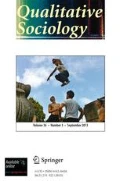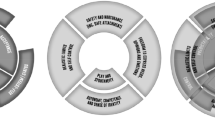Abstract
Millions of Americans feel the need to carry guns with them everywhere they go. They feel this need in their minds as well as in their bodies. Cognitively, they feel their lives are in danger and physically, they feel unease when they are not carrying their guns. In this article, we demonstrate that the practice of carrying guns is constituted by both cognitive schemas about risk and safety, as well as sensory and embodied experiences of comfort, and even pleasure, in holding, shooting, and carrying a gun. As with other social practices, these cognitive schemas and embodied experiences are not innate, but rather learned. Drawing on interviews with 46 people who regularly carry guns, as well as fieldwork at firearms training schools, we examine the process by which people learn the cognitive schemas (how people think about guns) and embodied experiences (how people physically experience guns) associated with the practice of carrying guns.
Similar content being viewed by others
Notes
To protect confidentiality, we use pseudonyms to identify all people.
While states use different terms for licenses or permits to carry a concealed firearm, we use License to Carry (LTC) to refer to all such policies that allow gun owners to carry concealed handguns in public.
Beyond being places where students take the mandatory class required to obtain an LTC, gun schools are places where people take a broad array of classes, from those meant for beginners, to more advanced tactical self-defense training.
Women expressed a fear of being raped, while men expressed a fear of having their wives and daughters being raped.
Repeatedly, the sense of danger was gendered and racialized (with women usually being the ones needing protection, and black and brown men usually being the ones they need protection from). We address this in a working paper, “The Role of Race and Gender in How Gun Owners Perceive Risk.”
In firearms classes, students are encouraged to not only carry guns, but also engage in a range of behaviors meant to make them safer. This includes, most importantly, what is called “situational awareness,” in which people are taught to become cognizant of their surroundings and avoid “dangerous situations.” However, ultimately, our research shows that firearms instructors and people who carry guns believe, and teach people to believe, that they need guns and that if they are not carrying a gun at all times, they are not as safe, even if they engage in the other sets of behaviors (such as carrying pepper spray or having situational awareness).
While shooting someone does not necessarily have to result in death, firearms schools train specifically to not just injure but to kill. Indeed, instructors make a concerted effort to teach students that injuring someone does not guarantee your safety because that individual can “continue to fight.”
References
Azrael, Deborah, Lisa Hepburn, David Hemenway, and Matthew Miller. 2017. The stock and flow of U.S. firearms: Results from the 2015 national firearms survey. RSF: The Russell Sage Foundation Journal of the Social Sciences 3 (5): 38–57. https://doi.org/10.7758/RSF.2017.3.5.02.
Bankston, W.B., et al. 1990. The influence of fear of crime, gender, and southern culture on carrying firearms for protection. The Sociological Quarterly 31 (2): 287–305.
Bobo, Jason. 2007. Following the trend: Alabama abandons the duty to retreat and encourages citizens to stand their ground. Cumberland Law Review 38: 339–370.
Bourdieu, Pierre. 1990a. The logic of practice. Cambridge: Polity Press.
Bourdieu, Pierre. 1990b. In other words: Essays towards a reflexive sociology. Stanford: Stanford University Press.
Bourdieu, Pierre. 2000 [1997]. Pascalian meditations. Cambridge: Polity Press.
Carlson, Jennifer. 2015. Citizen protectors: The everyday politics of guns in an age of decline. New York: Oxford University Press.
Carter, Jeremy, and Michael Binder. 2016. Firearm violence and effects on concealed gun carrying: Large debate and small effects. Journal of Interpersonal Violence :1–26.
Catalfamo, Christine. 2007. Stand your ground: Florida’s castle doctrine for the twenty-first century. Rutgers Journal of Law and Public Policy 4: 504–545.
Celinksa, Katarzyna. 2007. Individualism and collectivism in America: The case of gun ownership and attitudes towards gun control. Sociological Perspectives 50 (2): 229–247.
Dixon, Jo, and Alan J. Lizotte. 1987. Gun ownership and the ‘southern subculture of violence’. American Journal of Sociology 93 (2): 383–405.
Drake, Denise. 2008. The castle doctrine: An expanding right to stand your ground. St. Mary’s Law Journal 39: 573–614.
Felson, Richard, and Paul-Philippe Pare. 2010. Gun cultures or honor cultures? Explaining regional and race differences in weapon carrying. Social Forces 88 (3): 1357–1378.
Filindra, Alexandra, and Noah Kaplan. 2016. Racial resentment and white gun policy preferences in contemporary America. Political Behavior 38 (2): 255–275.
Garcia, Raul Sanchez, and Dale C. Spencer. 2013. Fighting scholars: Habitus and ethnographies of martial arts and combat sports. New York: Anthem Press.
Gau, Jacinta. 2008. A neighborhood-level analysis of concealed-handgun permits. Policing 31 (4): 674–693.
Grossman, Richard, and Stephen Lee. 2008. May issue versus shall issue: Explaining the pattern of concealed-carry handgun laws, 1960-2001. Contemporary Economic Policy 26 (2): 198–206.
Harcourt, Bernard. 2006. Language of the gun: Youth, crime, and public policy. Chicago: The University of Chicago Press.
Hemenway, David, et al. 1995. Firearms and community feelings of safety. The Journal of Criminal Law and Criminology 86: 121–132.
Johnson, Nicholas. 2014. Negroes and the gun: The black tradition of arms. New York: Prometheus Books.
Lott, John. 2016. Concealed carry permit holders across the United States: 2016. Swarthmore: Crime Prevention Research Center Available at SSRN: http://ssrn.com/abstract=2814691.
O’Brien, Kerry, Walter Forrest, Dermot Lynott, Michael Daly, and Brock Bastian. 2013. Racism, gun ownership and gun control: Biased attitudes in US whites may influence. Policy Decisions 8 (10): e77552.
Pederson, Jo Ellen, et al. 2015. Gun ownership and attitudes toward gun control in older adults: Re-examining self interest theory. American Journal of Social Research 1 (5): 273–281.
Pew Research Center for the People and the Press. 2013. Why own a gun? Protection is now top reason. March 12, 2013. http://www.people-press.org/2013/03/12/why-own-a-gun-protection-is-now-top-reason.
Shapira, Harel, Katherine Jensen, and Ken-Hou Lin. 2017. Trends and patterns of concealed handgun license applications: A multistate analysis. Social Currents 5 (1): 3–14.
Spitzer, Robert. 2015. Guns across America: Reconciling gun rules and rights. Oxford: Oxford University Press.
Stroebe, Wolfgang, N. Pntus Leander, and Arie W. Jruglanski. 2017. Is it a dangerous world out there? The motivational bases of American gun ownership. Personality and Social Psychology Bulletin 43 (8): 1071–1085.
Stroud, Angela. 2016. Good guys with guns: The appeal and consequences of concealed carry. Chapel Hill: University of North Carolina Press.
Tarr, Jen. 2008. Habit and conscious control: Ethnography and embodiment in the Alexander Technique. Ethnography 9 (4): 477–497.
Thompson, Joel A., and Ronald Stidham. 2010. Packing heat in the Tar Heel State: A county-level assessment of concealed carry permits. Criminal Justice Review 35 (1): 52–66.
United States Department of Justice, Federal Bureau of Investigation. 2016. Crime in the United States, 2015. Washington, D.C.
Wacquant, Loic. 2004. Body and soul: Notebooks of an apprentice boxer. New York: Oxford University Press.
Wacquant, Loic. 2014. Homines in extremis: What fighting scholars teach us about habitus. Body & Society 20 (2): 3–17.
West, Candace, and Don Zimmerman. 1987. Doing gender. Gender and Society 1 (2): 125–151.
Winkler, Adam. 2011. Gunfight: The battle over the right to bear arms in America. New York: W.W. Norton and Co.
Yamane, David. 2017. The sociology of U.S. gun culture. Sociology Compass 11 (7). https://doi.org/10.1111/soc4.12497.
Young, Robert L. 1986. Gender, region of socialization, and ownership of protective firearms. Rural Sociology 51: 169–182.
Acknowledgments
We thank Shamus Khan, Christine Williams, and David Yamane for feedback they gave us on earlier versions of this article. We are also particularly grateful for the insights and encouragements provided by David Smilde throughout the editorial process. This publication was made possible in part by a grant from Carnegie Corporation of New York. The statements made and views expressed are solely the responsibility of the authors.
Author information
Authors and Affiliations
Corresponding author
Rights and permissions
About this article
Cite this article
Shapira, H., Simon, S.J. Learning to Need a Gun. Qual Sociol 41, 1–20 (2018). https://doi.org/10.1007/s11133-018-9374-2
Published:
Issue Date:
DOI: https://doi.org/10.1007/s11133-018-9374-2




